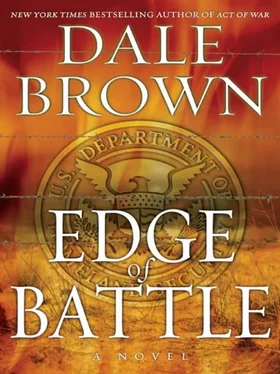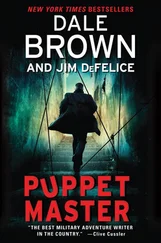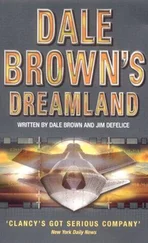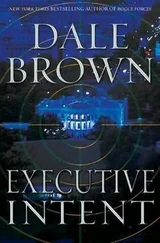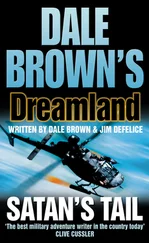Jason carried Yegor Zakharov outside to the waiting CV-22 Os-prey tilt-rotor aircraft, surrounded by both Task Force TALON commandos and Mexican army soldiers. Internal Affairs agents and employees were being escorted out of the ministry buildings at gunpoint, and boxes of records were being carried out and loaded into trucks. “So, Major Richter,” Zakharov said casually, “I have done what you have asked. You should let me go now. That was part of our deal, was it not?”
“It was not,” the robot’s electronic voice replied.
“Then you intend to kill me, after all I have done for you?”
In the blink of an eye, the robot spun Zakharov around so he was now facing the robot, still suspended in the robot’s grasp; then, Richter deployed the twenty-millimeter cannon in his weapon backpack. The huge muzzle of the weapon was now pointed forward over the robot’s right shoulder, inches away from Zakharov’s face.
“I could do it now, Zakharov,” Jason said, the robotic voice slow and measured, “and no one would say a damned thing about it.”
“I could have slaughtered Vega’s entire family…!”
“Everyone expected you to do it. We were prepared for it, believe me.”
“But I did not do it, Major. I spared them, turned myself in, and helped you get Díaz.”
“You think you’re a big hero now?”
“There is so much more I could tell you, Richter,” Zakharov said. “I could give you information that would put you within reach of thousands of the world’s greatest criminals. Your task force could capture them, and then you would be the hero. All I am asking for is my freedom. I will give you my information. You check it out and verify its credibility. Then you fly me to a wadi in the Sahara or a deserted island in Indonesia, and we both live out the rest of our lives free from ever having to deal with one another again.”
The robot suddenly turned away from the CV-22 and ran quickly out of the Internal Affairs Ministry compound, heading east until it came on an open area of the Bosque de Chapultepec. Then, to Zakharov’s complete amazement, the robot dropped him. Zakharov was on his feet in an instant, looking around in the darkness. The brilliant lights of Mexico City illuminated the horizon in all directions except to the west; the light surrounding the Castillo de Chapultepec, the now-vacant Mexican president’s residence, could be seen a short distance away.
“What are you doing, Richter?” Zakharov asked.
Jason said nothing for several long moments; then, Zakharov heard him say: “Run.”
“What?”
“Run, Colonel,” Richter said. “I’ll give you five minutes. You might be able to make it to the Castillo, probably to Constitution Avenue, and once you cross there you’ll be in the heart of that residential neighborhood. Run.”
Zakharov took several steps backward and looked around himself again. Yes, he thought, he could easily make it to Constitution Avenue, and immediately he’d be in the San Miguel Chapultepec neighborhood, a mixture of wealthy homes and upscale businesses—perhaps even sympathetic Russian expatriates or oil company executives that he once did business with. The robot was good out in the open but bad in narrow alleyways and terrible indoors…yes, he might just make it. Go, he told himself, go, now …!
But as he stepped back, he saw the muzzle of that twenty-millimeter cannon tracking his head, aimed right between his eyes, and he knew that Richter had no intention of letting him go. He would let him run a short distance, then open fire. Like he said, no one in Mexico, the United States, or most anywhere in the world would blink an eye over his death.
Zakharov turned, dropped to his knees, and raised his arms to his side. The robot grasped his arms and pulled him effortlessly off his feet.
“Smart choice, Colonel,” Jason Richter said, as they headed back toward the Internal Affairs Ministry complex. “Smart choice.”
EPILOGUE
SAN DIEGO, CALIFORNIA
WEEKS LATER
The speeches and proclamations were finally concluded. Underneath an arch of balloons and flags of Mexico and the United States fluttering in the cool breeze, the new president of the United Mexican States, Alberto Rojas, and the President of the United States, Samuel Conrad, stepped off the dais and into a new building erected just outside the Tijuana-San Diego border crossing and up to a special kiosk.
While TV cameras and dozens of reporters recorded everything, Rojas stepped up to the person behind the counter—Director of U.S. Customs and Border Protection James A. Abernathy himself—shook hands, and gave him his Mexican identification card and birth certificate. Abernathy handed the documents to a technician, who scanned the documents into a computer and gave them back. Rojas then stepped onto a designated spot on the floor, smiled as a digital photograph was taken, then pressed the thumbs from each hand onto a digital fingerprint reader. Finally he took a white capsule from a dispenser, held it up for all the reporters to see, swallowed it, and downed it with a glass of champagne.
Following Rojas, the President of the United States did the very same procedure, including downing an NIS capsule. He then raised his own glass of champagne to Alberto Rojas and took a sip. Immediately afterward, the new Mexican Minister of Internal Affairs, Minister of Justice, and Minister of Foreign Affairs repeated the procedure, followed immediately by their American counterparts, and they toasted one another for all to see. Then the dignitaries watched as thousands of Mexican migrants started to follow the identification procedure. After a few minutes of photos, the dignitaries moved on, letting the Customs and Border Protection officers get to work processing the thousands of Mexican citizens returning to their lives and jobs in the United States.
“It doesn’t solve a damned thing, does it?” Mike Tesch asked over the command channel as he watched a televised image of the proceedings on his electronic visor. He and several other members of Task Force TALON were piloting Cybernetic Infantry Devices just a short distance away, out of range of the TV cameras but ready to respond in case of a terrorist incident during the ceremonies. “Those who want to sneak into the United States illegally will still do so; those who hire illegals will still do it; smugglers who help them sneak in will still help them. Stuff like the Nanotransponder Identification System just punishes the law-abiding persons.”
“It doesn’t punish anyone, Mike,” Jennifer McCracken radioed back. “NIS is just a twenty-first-century ID card, that’s all. ID cards aren’t meant to solve anything.” She paused, then added, “It’s a start. There’s still so much to discuss, still so much legislation to write, still so many compromises to make. But it’s a start.” Just then, there was a beep in her headset. “Go ahead, TALON,” she replied.
“Condor has spotted a situation about seven hundred meters northeast of your position,” Ariadna Vega, in the control center for the Condor unmanned aerial reconnaissance airship, which was orbiting over the border area during the ceremonies. “Might be a demonstration on a street corner—I see some garbage on fire and about twenty individuals. Move a few blocks from the target on the west side of Route Nine-Oh-Five and stand by to assist the sheriffs department if necessary.”
“Copy, TALON,” Jennifer responded, and she started running alongside Interstate 5 north to her staging area.
Something made Ariadna look up from her console in the Condor monitoring and control center at the Pecos East headquarters of Task Force TALON at Cannon Air Force Base in New Mexico. She turned and saw Jason Richter watching her. “How long have you been there, J?” she asked.
Читать дальше
